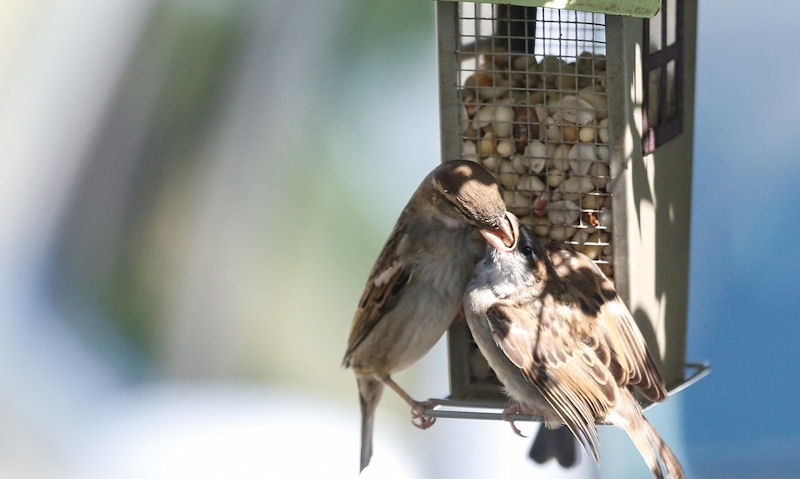How to feed peanuts to birds
It isn't all that difficult to feed peanuts to our wild birds, because they will find them in bird feeders, on the ground, or on high surfaces where they can be safely located.
How to feed peanuts to birds is done so in and out of bird feeders, this way bird feeder birds will cling to the wire mesh to poke their bills in to feed; while at the same time less able wild birds can eat peanuts placed in open dishes, or in a tray. Go slowly at first, then increase/decrease peanut use with demand.
Feeding peanuts to birds is an all year round job, particularly in winter as the protein and fatty content is needed to fatten up the wild birds who rapidly lose weight at this time of year.
Birds who do eat peanuts will happily come to a specialty peanut bird feeder, which is essentially a cylinder shape bird feeder, built with a wire mesh metal cage.
How birds feed on peanuts off this kind bird feeder, would be by clinging on to the wire cage exterior - too poke their bills in to pull out what will now be broken up peanuts.
Peanuts are stored within the feeder with the gaps in between the wire not wide enough to pull out whole peanuts; thus peanuts are bitten and broken up, which does contribute to how the mess is made under bird feeders.
Expect common backyard birds to feed on peanuts store this way, but its vitally important to feed peanuts to birds out of bird feeders.
Larger, less able birds like Blue Jays will want to eat peanuts and to be fair, are found to eat off bird feeders with ease. Only peanut feeders provide no perch, thus this much larger common bird, will find it too hard to cling on at an awkward angle.
How else you feed birds' peanuts then is out of bird feeders, with a bird feeder tray or a heavy ceramic dish perfectly acceptable to store peanuts.
In fact, you can provide all kinds of nuts to wild birds this way, as not all will go in feeders.
Utilize safe, high up structure locations in your yard to place peanuts in and out of their shells. While its also possible to put shelled peanuts in a wreath feeder which can hang among other bird feeders, on a bird feeder pole or branch.
When providing peanuts to wild birds in and out of bird feeders in spring through summertime, be mindful of adult birds bringing large chunks of peanuts back to the nest, to feed their young. With that in mind, crush peanuts up at this time of year to avoid the hatchlings choking on too big peanut chunks.
Fed in reliable NUT feeders
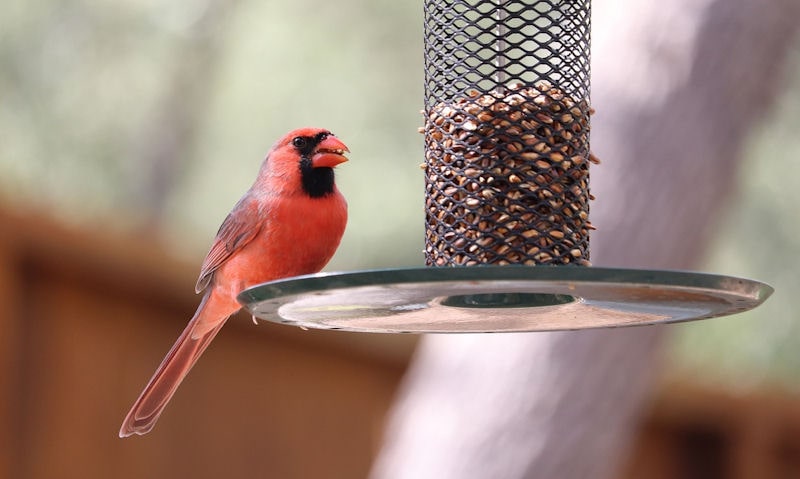
How you would provide peanuts in the yard is within a corresponding peanut bird feeder, which is specifically designed to store whole or peanut kernels. Peanuts out of shells, as oppose to peanuts in their shell, will use a whole different kind of nut feeder.
As it happens, a classic wire mesh peanut feeder will largely be one of the top five bird feeders suspended off a pole or tree branch.
And when the time is right, a whole mix of wild bird species will converge on this protein-rich, peanut-filled bird feeder.
Reliable as peanut bird feeders are, a mix of peanut bird feeder types are available which will cater to peoples needs and tastes.
Most popular way to feed peanuts to birds is in a cheap nut bird feeder that is small, uses a flimsy wire mesh, and is made to hang. How you would normally fill it, would be by simply unscrewing or popping off the lid on top.
Similar types of peanut bird feeders you can utilize will be far more expensive wooden peanut bird feeders - or novelty Acorn shape peanut feeders you can buy.
Best way to feed peanuts in bulk to wild birds is with a reliable but cheap to buy feeder.
What birds feed off this kind of feeder will be among others: Nuthatches if in the area; always popular with Chickadees; when Wren's rarely turn up at feeders; Titmouse of course; and then there's most Woodpeckers who adore peanuts in or out of shells.
I will say Blue Jays also love peanuts in or out of shells, yet will find it hard to feed on peanuts when provided in a suspended, too confined bird feeder.
Open to all Nut-eating birds
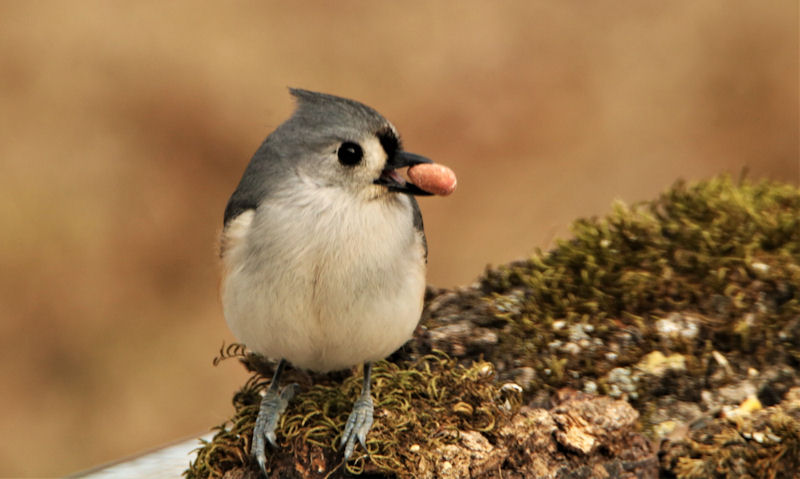
To be sure much larger, less agile ground feeding birds like Blue Jays and Northern Cardinals can access peanuts to eat in our yards - let's provide peanuts out of bird feeders to scatter on visible, yet highly accessible areas outdoors.
Open your mix of peanuts to all peanut eating birds like Blue Jays and Cardinals by placing peanuts on top of fence panel, roofs of our outdoor structures like sheds or garages - with an option to put nuts within nature - such as tree stumps or on branches.
Cardinals and Blue Jays are ground feeding birds, thus some peanuts can also be fed to birds on the lawn or better yet, scatter them over the patio or deck.
When your peanuts don't go far enough due to availability, crush them up when provided them out of feeders, as you'll double or triple peanut quantity.
Peanut bird feeders work to feed bird feeder able birds, but not others who usually avoid bird feeders all together.
To be sure the peanuts are eaten, and our wild bird can find them, think about scattering peanuts across multiple locations; including putting it on top of outdoor furniture, and even window ledges - if that is where peanut-eating birds reside in your property.
Peanuts offered out of feeders
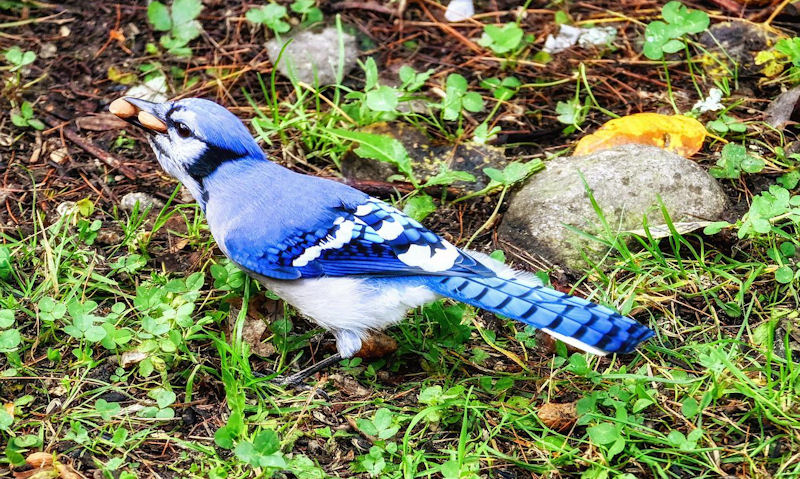
Why its important to provide peanuts out of bird feeders, would be to guarantee those wild birds that want to eat your peanuts can.
Peanuts stuffed in a suspended, too confined wire mesh bird feeder won't be enough to feed all birds.
Remember, a lot of bird feeder birds aren't all that capable at feeders at all. And while they can use it at times, they would very much prefer to avoid it unless its an open top platform bird feeder - or a dish used to put bird feed in out in the yard.
Provide peanuts to a larger mix of wild birds, while at the same time guarantee more peanuts are eaten, when made available out in the open.
With that in mind, I would utilize a mounted bird feeder tray or the kind of bird feeder platform that is made to be hung, mounted on top of a post, or it goes on the ground.
Ground bird feeders must be used in conjunction with suspended bird feeders, which is the only way to keep squirrels or rats out of peanut bird feeders, and other many kinds.
How you feed peanuts to birds with a squirrel problem in your yard, could rely on a squirrel proof peanut feeder, which is essentially a basic wire mesh nut feeder, that is shrouded in the center of a squirrel proof wire cage.
Build up peanut use with demand
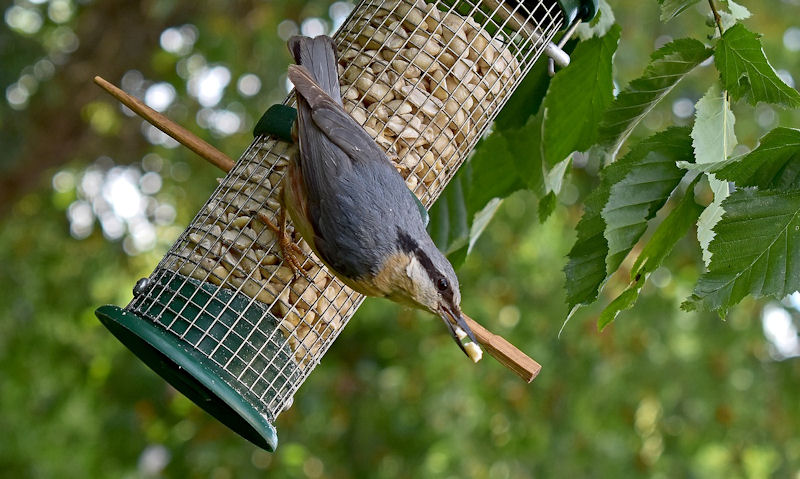
Now that you know to feed peanuts to birds in and out of bird feeders, to ensure the largest group of wild birds can actually access the peanuts to eat, let's talk a little about how much or little peanuts must be provided.
Many wild birds do eat peanuts but if there's seeds, dried mealworms and other yummy treats provided in bird feeders - where unfortunately, wild birds will prioritize other bird feed over peanuts.
Peanuts out of shells which are also provided in bird feeders will are eaten - that I can assure you - only they will be eaten at a slower pace, over a long period of time. Result of that is, more peanuts will be wasted unless you get the measurement right.
What you do then, would be to provide as little peanuts in a peanut bird feeder - including in a tray or placed on a backyard surface for now - as you gradually build up more or less peanuts... which will depend on demand at certain times of the year.
"I regularly witness the wild birds who visit my bird feeding station, will ignore the peanut bird feeder until the seeds and suet cakes have been fully eaten up."
Peanuts come in smaller quantities when compared to wild bird seeds for example, due to far more common backyard birds eating seeds in greater frequency - as its part of their diet in the wild - and so will eat peanuts and other bird feed far less.
With that, start out feeding peanuts - again in and out of bird feeders - with fewer peanuts at first, to avoid them rotting as they go to waste.
You will want to use more peanuts if they appear to be quite popular, while at the same time be mindful of peanut use can decline as the weather gets warmer.
Conclusion
It really isn't all that difficult to feed peanuts to wild birds, because it relies on a cheap but very basic peanut bird feeder; you could scatter peanuts on the ground, or carefully place peanuts where wild birds can find them around the yard.
I will say, of all wild bird feed you can put out in the yard, peanuts do appear to be used less, which is true for my personal circumstances.
Knowing that, how you will feed peanuts to birds is with and without a peanut bird feeder.
Birds who are peanut-eating and can manage on any suspended bird feeder, will do so by perching or clinging to the side of the mesh wire cage. And wild birds who are less able on hanging bird feeders, will be happy to feed on peanuts placed on the ground - or placed on a safe, higher up surfaces in the yard.
Birds who will prefer to feed on peanuts in and out of their shells, and also out of bird feeders, will be the much larger, but less able Cardinals or Jays.
With that, larger birds like this can be fed peanuts that are provided in a mounted bird feeder tray, or when throwing peanuts in a dish.
While at the same time you can expect most Woodpeckers, Chickadees, Sparrows, Titmouse and of course Nuthatches to access peanuts in more compact but suspended peanut bird feeders.
